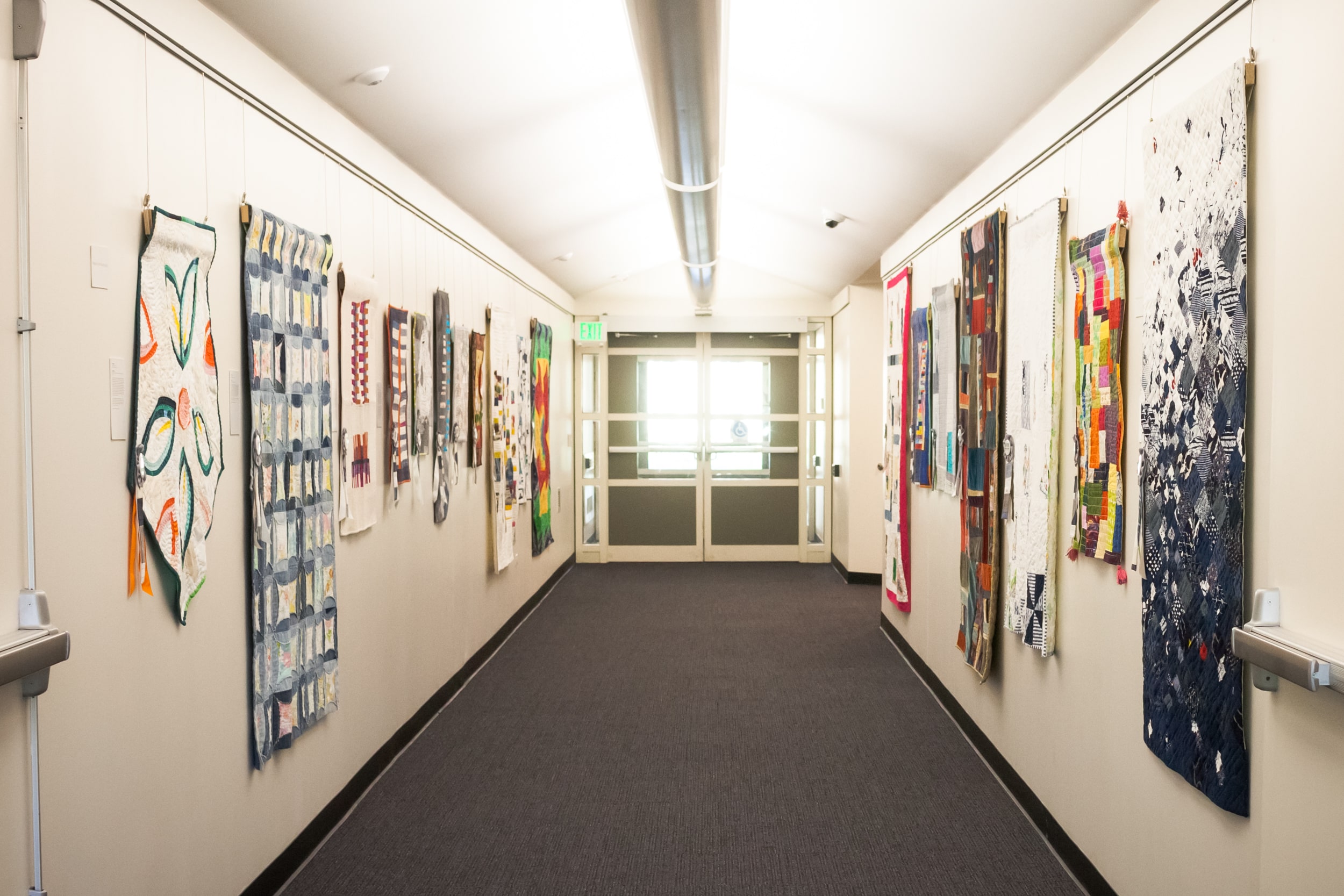
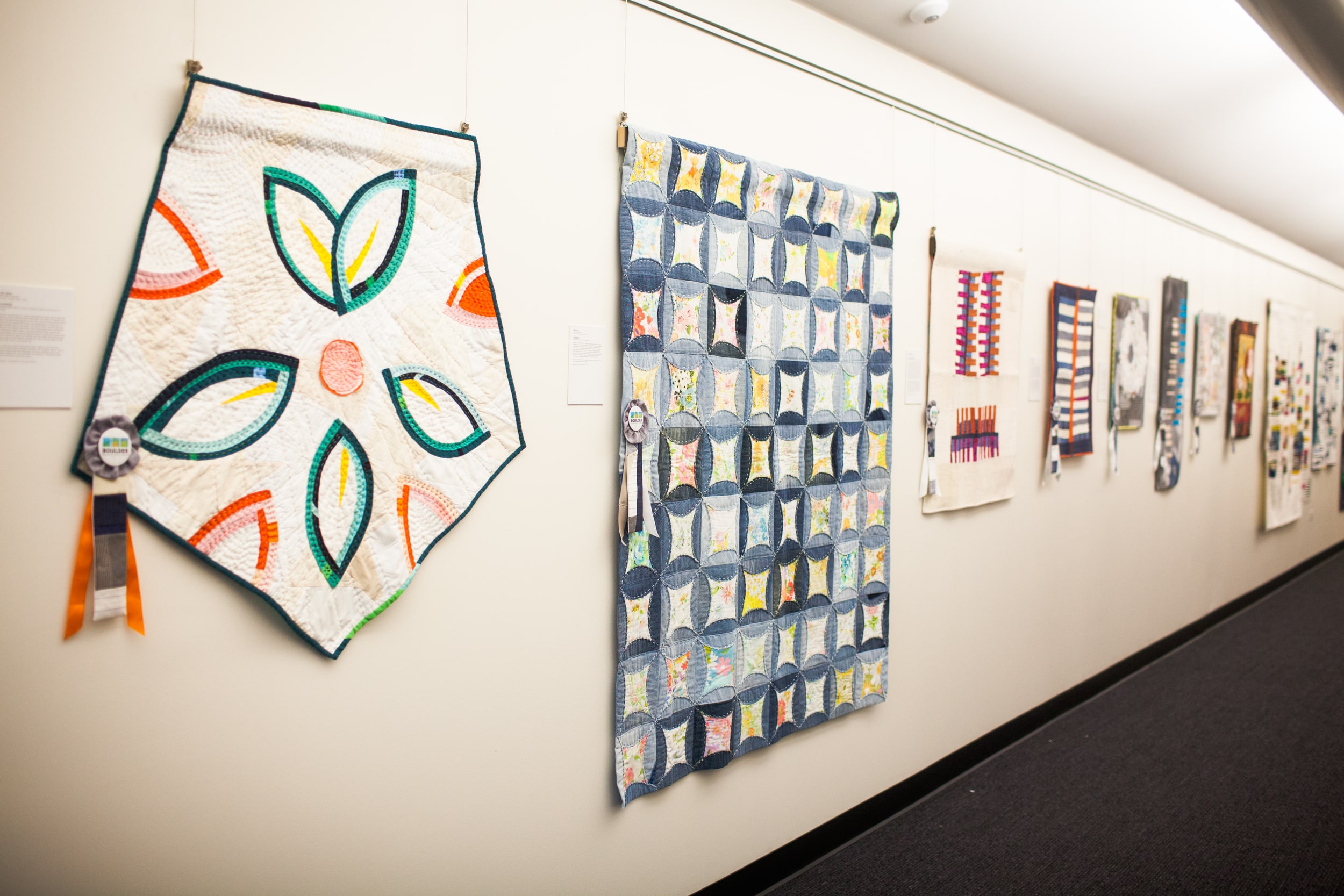
On October 4, 2018 the Boulder Modern Quilt Guild opened our first show. An Exploration of Sustainable Modern Quilting hung at the Albert A. Bartlett Science and Communication Center, CU Boulder, through December 14, 2018. In conjunction with the Sustainability, Energy and Environment Community, the BoulderMQG presented 18 quilts made by amazing artists who reside throughout the central and northern Colorado Front Range.
Participants were encouraged to enter quilts that fell within these five categories: repurposed, rescued fabrics; renewable, sustainable new fabrics; scraps, waste, and otherwise trashed pieces of fabric; repaired, restored, and reworked ‘old’ quilts into new quilts; unusual materials. Below we are sharing some of the quilts that hung at the show.
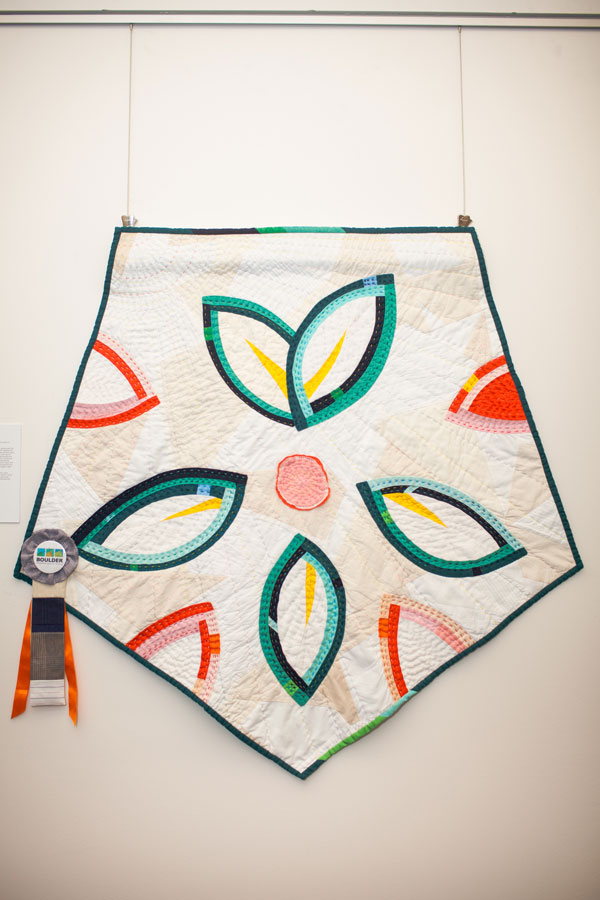
Julie Sippy
Thornton, Colorado
Boulder Modern Quilt Guild
[untitled]
mixed cotton fabrics, a mix of leftover batting, perle cotton 8 thread
I felt the symbolism of a flower spreading its petals epitomized the identity of the material used in the quilt. Old, cast-off material has been repurposed and given a new life, just as a flower blooms every spring. In the upper left corner is an abstracted sun with rays of light radiating across the quilt. The flower itself is abstracted and reduced into petals and center, and the background is comprised of randomly sized creamy white and beige scraps resembling stained glass. All of the top stitching was completed by hand, with colors chosen to playfully interact with the fabric and add texture. The center of the flower has been left with a frayed edge to add additional texture and dimension.
This quilt was assembled using cotton fabrics found in a tiny second hand store in Newton, Kansas. “Fill a bag for $1.00.” Some pieces looked like they had been cut from clothing, and a few pieces came from my scrap bin. The batting is “Frankensteined” from remnants of previous quilts.
category: repurposed, rescued fabrics
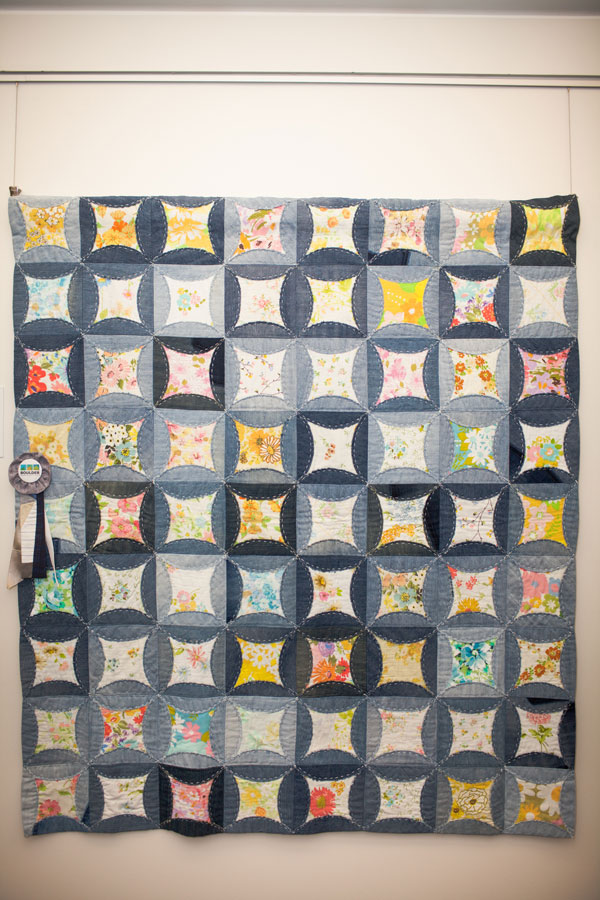
Erin Amos
Denver, Colorado
Denver Metro Modern Quilt Guild
[untitled]
denim, cotton fabric, cotton batting
Inspired by the traditional cathedral window quilt design, I used an updated construction technique to showcase the raw, frayed edges of the denim. This quilt has a lot of meaning to me because the denim is from my husband’s jeans and the “windows” are vintage linens from his mother and grandmother as well as some of my own collection. The recycled materials give it a softness that you only get after dozens of washes. Using recycled and rescued materials (like the scraps of batting used inside the quilt) gives it another layer of meaning and makes it an instant heirloom.
Denim is recycled from my husband’s old jeans, vintage linens from family, batting is from the scrap bin.
category: repurposed, rescued fabrics
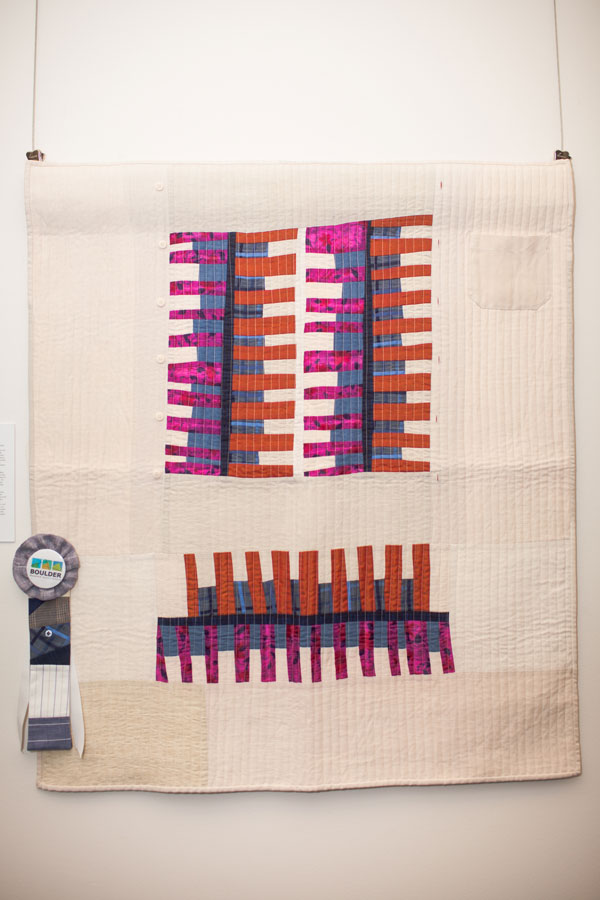
Stephanie Ruyle
Denver, Colorado
Denver Metro Modern Quilt Guild
Shirts, Skirts, and a Sari
upcycled clothing, vintage table cloth, remnant bamboo batting
Sometimes a quilt’s DNA isn’t a mystery and paying homage to its roots is just as important as celebrating its future. “Look at me” became the mantra of this quilt which pays tribute to some unexpected materials including a shirt placket with its original buttons and button holes as well as the shirt’s pocket (which was removed for quilting and then stitched by hand back into place so it remained a functional pocket). The back, which is of co-equal importance, is a vintage card table tablecloth that belonged to my husband’s grandmother. It had a few holes from repeated use, which were reinforced from behind so they they would be stable but remain visible. The stains are original and serve to address the functional origins of the tablecloth and the future functional use of the quilt. The tablecloth had been residing unused in a closet. Its use as “whole cloth” for the back is the epitome of what should happen to much loved family textiles, that have been retired, but long to be part of family celebrations once again.
Sustainability encompasses many aspects of creating, and being able to use all parts of the base materials in this quilt was a personal challenge and a planned design statement. Including the shirt placket with the original button and button holes instead of discarding this portion of the shirt makes it sustainable and a bit whimsical. I could have removed the buttons and reused them, but then the paired opposite side of the placket would have been unbalanced. The same applies to the shirt pocket, which, as it should, remains functional. Being able to use the entire tablecloth on the back, stains and all, celebrates a once loved but up-to-now retired textile in the best possible way.
category: repurposed, rescued fabrics
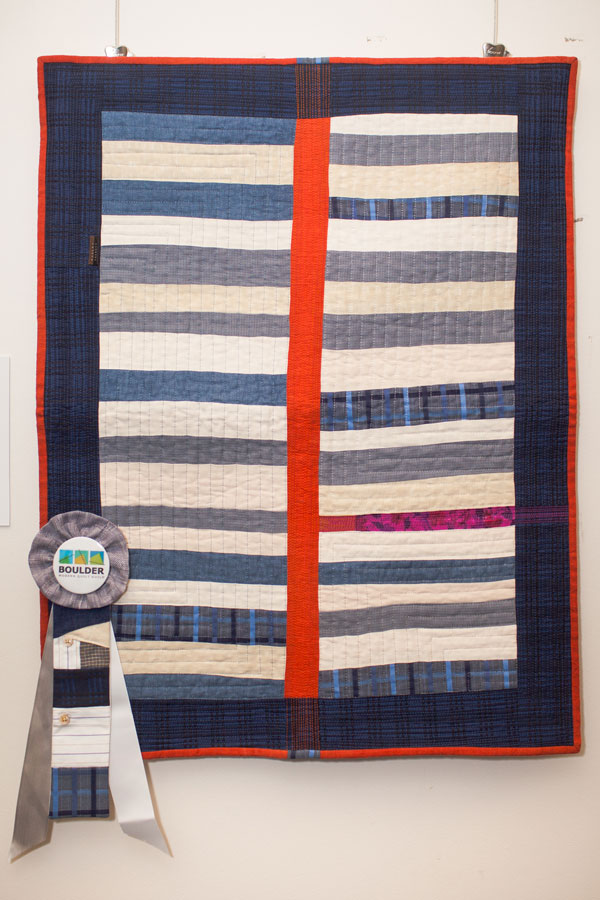
Stephanie Ruyle
Denver, Colorado
Denver Metro Modern Quilt Guild
Coastal Modern
clothing (cotton/linen/silk), antique quilt, various threads
This small quilt has a lot to say about the future of quilting as well as its past. Nothing new was used to make this quilt. Improv pieced upcycled old clothes comprise the top. The batting/backing is a rescued (loved-to-death or abused, depending on your point of view) antique quilt that has seem much better days. All the thread comes from nearly empty bobbins yearning to be used again. You can appreciate the kinds of threads and the number of different colors of threads used by studying the quilt back. Most of the thread composition is unknown, but some of the more interesting ones include solar-reactive thread and various metallics. The binding is intentionally pieced to compliment the overall composition. Although I have made several quilts from scrap quilting material, this the first quilt I have made from 100% up-cycled and “unconventional” materials.
{Something OLD, Nothing NEW, Something BORROWED, Something BLUE} sums up the philosophy of Coastal Modern. The clothing used to make this quilt was dated and stained, needing repair, and unsuitable for donation. In addition, using nearly empty bobbin thread instead of discarding the last little pieces keeps all those loose threads out of the landfill. I was especially proud of purposefully using a damaged antique quilt as both the batting and backing. The front of the antique quilt becomes the back of this new quilt- blending the quilt’s future intimately with its past. Careful cutting of the antique quilt (which was really hard for me to do) allowed me to select the least damaged area to use in this project.
category: repurposed, rescued fabrics + repaired, restored, and reworked ‘old’ quilts into new quilts
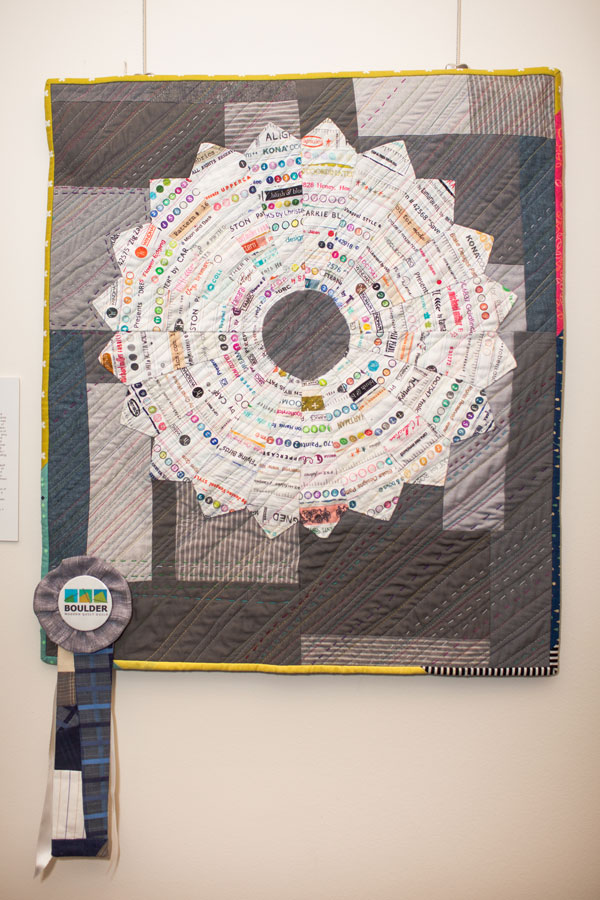
Rebecca Greco
Broomfield, Colorado
Boulder Modern Quilt Guild
[untitled]
selvages, men’s shirts, scraps of linen, sheets, cotton batting
I’ve never sewn with selvages before, but when a friend passed along a huge bag, I knew I wanted to incorporate them into a project. I recently made my first dresden, and I wanted to see if it was possible to make dresden blades with selvages. The thickness of the selvages did make it a challenge, but it worked out. The background fabrics are a mix of thrifted men’s shirts, leftover scraps of linen, and old sheets. The batting is scraps leftover from other projects and the backing is a piece of sheet. For the quilting, I used random bobbins of threads from old projects, as well as almost empty spools or spools of polyester that I have accumulated over the years but don’t use for quilting. I also added perle cotton 8 hand quilting. The binding is scraps of binding from other quilts I have made. I can never bring myself to get rid of the extra binding, even if it’s just a little bit.
As someone who usually works with a lot of color, creating a quilt with so much gray was strange for me. But I love the little bits of color that the selvage brings in, as well as the random colors of threads from old projects. It was a great challenge to creatively make something with items that would have normally been thrown out.
These selvages would have been thrown away, as well as scraps of fabrics from old projects. The men’s shirts were acquired from a thrift store, and the sheets were recycled as well. The batting pieces were all from old projects and even the thread was chosen to use up threads that I wouldn’t normally use.
category: scraps, waste, and otherwise trashed pieces of fabric + repurposed, rescued fabrics
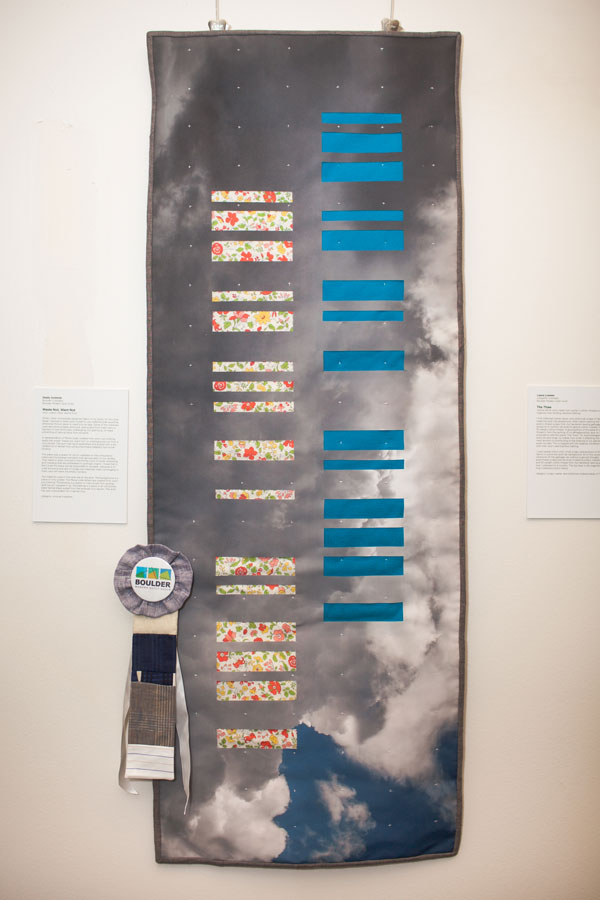
Shelly Sommer
Boulder, Colorado
Boulder Modern Quilt Guild
Waste Not, Want Not
vinyl, cotton, linen, dental floss
While I often incorporate reclaimed fabric in my quilts, for this challenge I wanted to really push myself to use materials that would be otherwise thrown away or used only as rags. Some of the materials used are nonrecyclable, and most were pulled from trash cans or rag bins. It was technically challenging, but gratifying, to make something of lasting value from discards.
A representation of Morse code, created from worn out clothing, spells the words “waste not, want not” on a background cut from a vinyl poster. The quilt was hand-assembled and quilted with a discarded roll of dental floss using a technique adapted from bookbinding.
This piece was a space for me to meditate on the consumerist habits and throwaway mentality that are prevalent in our society. They stand in stark contrast to the thrifty roots of reuse, reworking, and mending that are embedded in quilting’s origins. I hope that in the future this piece will be impossible to recreate—because a circular economy and lack of single-use materials mean rummaging in trash cans will leave me empty-handed.
The materials used in this quilt are all discards. The background is a piece of vinyl poster. The Morse code letters are created from worn out clothing. The binding is a ribbon of linen sliced from another quilt top as I squared it up. The batting is a piece of an old buffalo plaid flannel sheet pulled from the recesses of a rag bin. The quilting uses a discarded roll of dental floss.
category: unusual materials
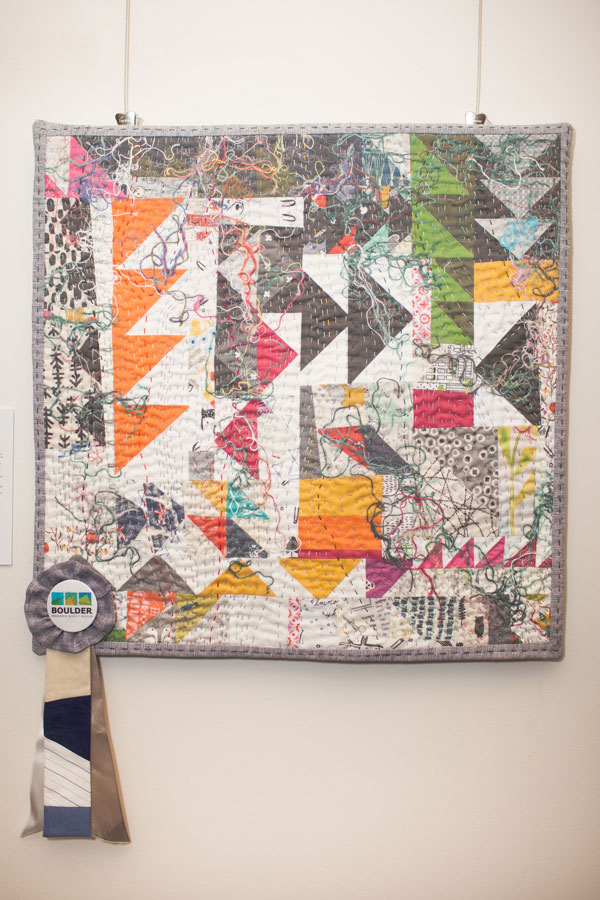
Laura Loewen
Lafayette, Colorado
Boulder Modern Quilt Guild
The Thaw
orphan block units made from quilter’s cotton, thread scraps, silk organza, linen binding, bamboo batting
I first collected orphan block units and small scraps of fabric to make the quilt top background. After improv piecing the top, I layered in thread scraps and tail ends of perle 8 cotton, metallic thread, and 50 weight cotton thread from my handwork sewing garbage that I collected for 6 months. A good portion of the perle 8 cotton thread is from the quilting of my #theglaciertwo quilt so I felt it appropriate to title this piece “The Thaw.” An acknowledgement that every bit and scrap, no matter how small, is affecting the environment around us contributing to the thawing of our glaciers and polar ice caps. This is topped with silk organza, bordered and faced with linen, and I used bamboo batting.
I used orphan block units, small scraps, and portions of throw-away fabrics to piece the quilt top background. All of this would have otherwise hit the garbage can without a second thought. I then layered thread scraps and tail ends of perle 8 cotton, metallic thread, and 50 weight cotton thread from my handwork sewing garbage that I collected for 6 months. The top layer is silk organza. The batting is bamboo/cotton blend.
category: scraps, waste, and otherwise trashed pieces of fabric
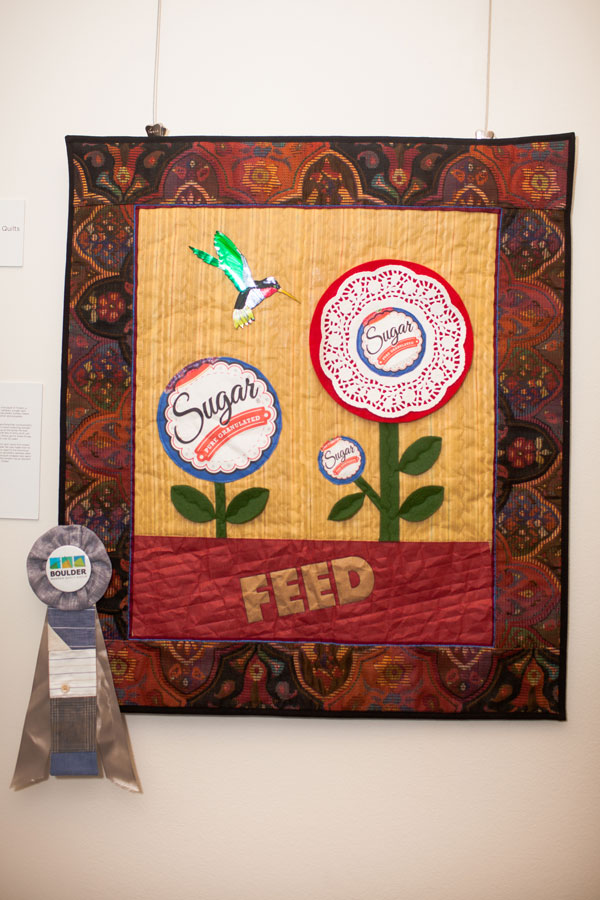
Colleen Harvey
Nederland, Colorado
Colorado Quilting Council
[untitled]
striped silk suiting, a tan wrapper from a bouquet of flowers, a barnyard feed sack (paper), upholstery samples, a sugar sack (paper), polyester felt made from recycled plastic bottles, fleece scraps, a paper doily, aluminum cans, cotton and polyester threads, and a glass bead
I’m a dedicated hoarder, hanging onto anything that could possibly be used in an art project someday. I can’t resist collecting wonderful treasures that would otherwise end up at the dump. My kids used to tease me for being fascinated with bits of shiny stuff, just like our chickens! It’s gratifying to finally find a use for these things, some of which have been in my stash for over 20 years.
The silk, cotton, and paper materials in my quilt came from renewable, compostable resources. The polyester felt was made from recycled plastic bottles. The aluminum cans used for the hummingbird are recyclable. The fleece scraps and upholstery samples were rescued waste products, and the floral bouquet wrapper was repurposed for use in the quilt. Everything in this project has an element of sustainability except for the polyester thread.
category: unusual materials
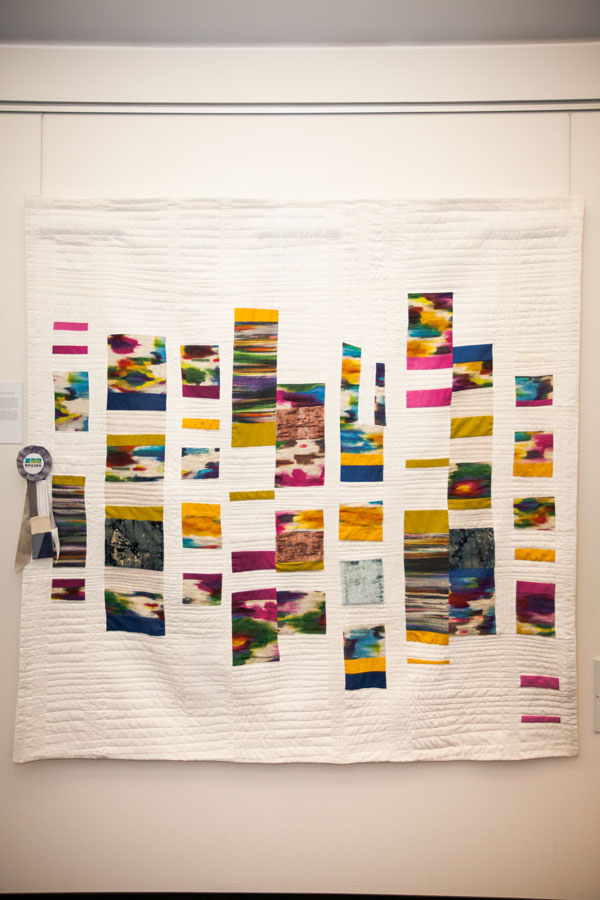
Scarlet Sparkuhl Delia
Fort Collins, Colorado
Fort Collins Modern Quilt Guild
Special Occasion
antique table linens, linen skirt, linen pants, discarded interior design swatches (velvet, linen, mixed wovens), cotton solids, cotton thread, wool batting
Often times we save beautiful household items for special occasions. Table linens, fine china, select vintage wines. As families age and traditions change, these coveted items are frequently hidden away in cupboards and closets, sadly decaying in darkness. Only when a family member becomes ill or passes, do we occasionally have the opportunity to bring them out again and recall the associated events: dinner parties, graduations, holiday celebrations. In this quilt, the use of my family’s household textiles and discarded interior design swatches gives them new life and purpose.
Materials used in this quilt include a majority of repurposed items. Interior design swatches (textile samples) are a notable source of textile waste. They are designed to represent a larger whole, used to demonstrate the look and feel of a particular fabric in real time. Although an essential part of the design process, these swatches are frequently discarded, further compounding the problem of textile waste. In this quilt the use of discarded swatches, table linens and linen garments gives them new life and a renewed purpose.
category: repurposed, rescued fabrics
Special thanks to the Sustainability, Energy and Environment Community, the Albert A. Bartlett Science Communication Center, Faurot Construction and DIV 6 Millwork, the BoulderMQG Show Committee and Jurors, and Stephanie Ruyle of Spontaneous Threads.
